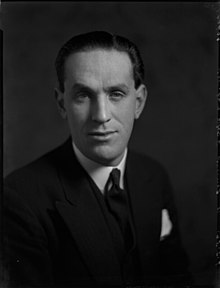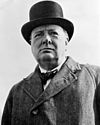Alan Lennox-Boyd, 1st Viscount Boyd of Merton
The Viscount Boyd of Merton | |
|---|---|
 | |
| Secretary of State for the Colonies | |
| In office 28 July 1954 – 14 October 1959 | |
| Monarch | Elizabeth II |
| Prime Minister | Winston Churchill Sir Anthony Eden Harold Macmillan |
| Preceded by | Oliver Lyttelton |
| Succeeded by | Iain Macleod |
| Personal details | |
| Born | 18 November 1904 |
| Died | 8 March 1983 (aged 78) |
| Resting place | Church of St Stephen, Saltash, Cornwall |
| Nationality | British |
| Political party | Conservative |
| Spouse(s) | Lady Patricia Guinness (1918–2001) |
| Education | Sherborne School |
| Alma mater | Christ Church, Oxford |
Alan Tindal Lennox-Boyd, 1st Viscount Boyd of Merton, CH, PC, DL (18 November 1904 – 8 March 1983), was a British Conservative politician.
Background, education and military service
Lennox-Boyd was the son of Alan Lennox-Boyd by his second wife Florence, daughter of James Warburton Begbie. He had an elder half-sister and three full brothers, two of whom were killed in the Second World War and one who died in Germany in April 1939. He was educated at Sherborne School, Dorset, and graduated from Christ Church, Oxford, with a BA later promoted to MA. In the Second World War he saw active service as a lieutenant in the Royal Naval Volunteer Reserve with Coastal Forces.[1]
Political career
Lennox-Boyd was elected as Member of Parliament (MP) for Mid Bedfordshire in 1931 (at the age of 26), and was admitted to Inner Temple, as a barrister in 1941. He was a member of Winston Churchill's peacetime government as Minister for Transport and Civil Aviation from 1952 to 1954. In this post he once memorably opined that road accidents were the result not of the taking of large risks, but of the taking of small risks very large numbers of times.
As a Minister, he opened the third Woodhead Tunnel on the British Railways electrified railway across the Pennines on 3 June 1954.[2]
In 1954 he became Secretary of State for the Colonies, where he oversaw early stages of decolonisation, with the granting of independence to Cyprus, Ghana, Iraq, Malaya and Sudan. He was in office during the Mau Mau Rebellion in Kenya, and was persuaded to stay in office by Harold Macmillan after being censured for the Hola massacre. He talked openly about independence for the Federation of Malaya, and invited the then Chief Minister of Malaya, Tunku Abdul Rahman and his colleagues to Lancaster House to discuss the possibility of independence.
Following the Suez Crisis of 1956, Lennox-Boyd appears to have made the initial approach to writer Ian Fleming about the possibility of Prime Minister Sir Anthony Eden's using Fleming's Jamaican house, Goldeneye, for a rest cure given the precarious state of Eden's health. Because of security considerations, he initially intimated to Fleming that he wanted Goldeneye for a holiday of his own and, when he resisted Fleming's suggestion that his and Fleming's wife (a close friend of Lady Eden) liaise over the arrangements, Fleming at first assumed that he was planning an extra-marital assignation.[3]
After the 1959 general election, Lennox-Boyd was replaced as Colonial Secretary by Iain Macleod.
In September 1960 he was raised to the peerage as Viscount Boyd of Merton of Merton-in-Penninghame in the County of Wigtown. This caused a by-election for his Mid Bedfordshire constituency which was won by Stephen Hastings. He was further honoured the same year when he was appointed a Companion of Honour. Being opposed to the line taken in Harold Macmillan's Wind of Change speech, he subsequently became an early patron of the Conservative Monday Club.
Other public positions and business career
Lord Boyd of Merton held the office of Deputy Lieutenant of Bedfordshire between 1954 and 1960 and Deputy Lieutenant of Cornwall in 1965. He was managing director of Arthur Guinness & Sons between 1959 and 1967, and was a Companion of Honour and Privy Councillor.
Mau Mau rebellion
In June 1957, Lennox-Boyd, who was Secretary of State for the Colonies, received a secret memorandum written by Eric Griffiths-Jones, the attorney general of Kenya. The letter described the abuse of Mau Mau detainees. The memorandum was passed on by Sir Evelyn Baring, the Governor of Kenya, who is alleged to have added a cover letter asserting that inflicting "violent shock" is the only way to deal with Mau Mau insurgents.
In April 2011 a Guardian report[4] described a cache of government documents which may indicate that, despite clear briefings, Lennox-Boyd repeatedly denied that the abuses were happening, and publicly denounced those colonial officials who came forward to complain.
Personal life
Lord Boyd married Lady Patricia Guinness, daughter of Rupert Guinness, 2nd Earl of Iveagh, on 29 December 1938. His mother-in-law, the Countess of Iveagh, had been an MP in 1927-35 and he was brother-in-law to Sir Henry ('Chips') Channon, also an MP (1935–58), making them jointly a first mother-in-law and child-in-law set of MPs. They had three children:
- Simon Lennox-Boyd, 2nd Viscount Boyd of Merton (b. 7 December 1939)
- Hon. Christopher Lennox-Boyd (22 July 1941 – 3 August 2012)
- Hon. Mark Lennox-Boyd (b. 4 May 1943)
Lord Boyd was knocked down and killed by a car when walking across Fulham Road in London in March 1983, aged 78, and, after cremation, was buried at St Stephen's Church, Saltash, Cornwall.[5] He was succeeded by his eldest son, Simon.
Lady Boyd died in May 2001, aged 83. She gave her name to the Viscountess of Merton cup, awarded at the Cornwall Spring Flower Show.[6]
According to many sources Lennox-Boyd was a gay man.[7][8] He is depicted in James Lees-Milne's diary of 1942-1943, Ancestral Voices, as being infatuated with the American aesthete Stuart Preston.[9]
Arms
|
References
- ^ Flag 4 by Dudley Pope, London 1954
- ^ "The Woodhead Route". Railways of Britain. Archived from the original on 2 March 2008. Retrieved 27 January 2008.
- ^ Richard Davenport-Hines (2013) An English Affair
- ^ Cobain, Ian; Walker, Peter (11 April 2011). "Secret memo gave guidelines on abuse of Mau Mau in 1950s". The Guardian. London. Archived from the original on 12 April 2011.
- ^ Oxford Dictionary of National Biography, Volume 7. Oxford University Press. 2004. p. 25. ISBN 0-19-861357-1.Articly by Philip Murphy.
- ^ "Cornish gardens scoop four trophies". Smallholder.
- ^ Double lives – a history of sex and secrecy at Westminster, The Guardian, 16 May 2015
- ^ Covent Garden: The Untold Story : Dispatches from the English Culture War 1945-2000, Norman Lebrecht, UPNE, 2001, page 174
- ^ Lees-Milne, James. "Ancestral Voices". London: Faber and Faber (1984), ISBN 0571133258, pp. 173-182.
- ^ Debrett's Peerage. 2000.
External links
- 1904 births
- 1983 deaths
- 20th-century British lawyers
- Alumni of Christ Church, Oxford
- Anglo-Scots
- British people of the Mau Mau Uprising
- Conservative Party (UK) MPs for English constituencies
- Deputy Lieutenants of Bedfordshire
- Deputy Lieutenants of Cornwall
- Gay peers
- LGBT members of the Parliament of the United Kingdom
- LGBT politicians from England
- Members of the Inner Temple
- Members of the Order of the Companions of Honour
- Members of the Privy Council of the United Kingdom
- Ministers in the Churchill wartime government, 1940–1945
- People educated at Sherborne School
- Presidents of the Oxford Union
- Road incident deaths in Scotland
- Royal Naval Volunteer Reserve personnel of World War II
- Royal Navy officers
- Secretaries of State for Transport (UK)
- Secretaries of State for the Colonies
- UK MPs 1931–1935
- UK MPs 1935–1945
- UK MPs 1945–1950
- UK MPs 1950–1951
- UK MPs 1951–1955
- UK MPs 1955–1959
- UK MPs 1959–1964
- UK MPs who were granted peerages
- Viscounts in the Peerage of the United Kingdom
- Peers created by Elizabeth II

